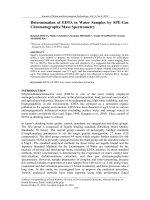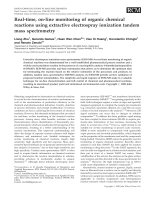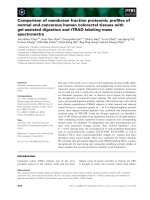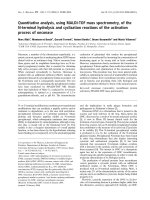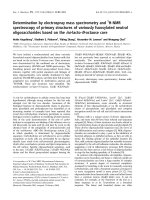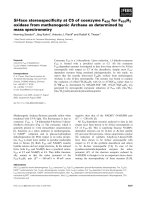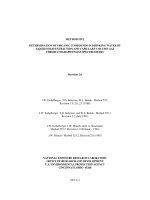Mass spectrometry MS basics herbert
Bạn đang xem bản rút gọn của tài liệu. Xem và tải ngay bản đầy đủ của tài liệu tại đây (32.98 MB, 473 trang )
MASS
SPECTROMETRY
BASICS
Christopher G. Herbert
Aobert A.W. Johnstone
CRC PRESS
Boca Raton London New York Washington, D.C.
Library of Congress Cataloging-in-Publication Data
Herbert, Christopher G.
Mass spectrometry basics I Christopher G. Herbert, Robert A.W. Johnstone.
p.; em.
Compilation of articles previously published in the series Back-to-basics.
Includes bibliographical references and index.
ISBN 0-8493- 1354-6 (alk. paper)
I. Mass spectrometry. 1. Johnstone, R.A.W. (Robert Alexander Walker) II. Title.
[DNLM: 1. Spectrum Analysis, Mass-Collected Works. 2. Spectrum Analysis,
Mass--Handbooks. QC 454.M3 H536m 2002]
QP519.9.M3 H47 2002
543'.0873-
2002025935
This book contains information obtained from authentic and highly regarded sources. Reprinted material is quoted with
permission, and sources are indicated. A wide variety of references are listed. Reasonable efforts have been made to publish
reliable data and information, but the author and the publisher cannot assume responsibility for the validity of all materials
or for the consequences of their use.
Neither this book nor any part may be reproduced or transmitted in any form or by any means, electronic or mechanical,
including photocopying, microfilming, and recording, or by any information storage or retrieval system, without prior
permission in writing from the publisher.
The consent of CRC Press LLC does not extend to copying for general distribution, for promotion, for creating new works,
or for resale. Specific permission must be obtained in writing from CRC Press LLC for such copying.
Direct all inquiries to CRC Press LLC, 2000 N.W. Corporate Blvd., Boca Raton, Florida 3343 \.
Trademark Notice: Product or corporate names may be trademarks or registered trademarks, and are used only for
identification and explanation, without intent to infringe.
Visit the CRC Press Web site at www.crcpress.com
© 2003 by CRe Press LLC
No claim to original U.S. Government works
International Standard Book Number 0-8493-1354-6
Library of Congress Card Number 2002025935
Printed in the United States of America 2 3 4 5 6 7 8 9 0
Printed on acid-free paper
Dedication
Dedicated to
Christine, Steven, and Fiona
RAWJ
Pauline, Daniel, Joseph, and Emma
CGH
Preface
This book began as a small series of brief articles designed to assist engineers and salesmen in
understanding some aspects of ion chemistry and mass spectrometry. Each article was composed
of a very short summary and a longer section that described aspects of the subject matter in
somewhat greater detail. To facilitate rapid reading and assimilation, extensive use was made of
figures and tables, which contain additional information in their legends or footnotes.
From the outset of writing these articles, it was never intended that they should be exhaustively
comprehensive, because this approach would have defeated the aims of the whole exercise, viz.,
the provision of short, quick explanations of major elements of mass spectrometry and closely
allied topics. The traditional, more all-embracing approach to writing about mass spectrometry was
left to the many excellent authors, who have provided impressive textbooks. In contrast, the major
objective of the Back-tv-Basics series was the provision of quick explanations of fundamental
concepts in mass spectrometry, without overelaboration. As far as possible, descriptions of processes, applications, and underlying science were made with a minimum of text backed up by
easily and rapidly understood pictures. Although some major equations of relevance to mass
spectrometry have been introduced, the mathematical derivations of these equations were largely
omitted. This was not an attempt to dumb down an important discipline. Rather, the intent was to
make some of the esoteric aspects of an important area of analysis readily comprehensible to the
many people who have to deal with mass spectrometers but who have not been trained specifically
in this branch of science and engineering. The series began about ten years ago and encompasses
recent and past developments in mass spectrometry. However, since it is the principles of mass
spectrometry that are explained and not specific instrumentation, the information content remains
as relevant now as it was ten years ago.
The effort to clarify and articulate the principles of spectrometry as simply as possible
appears to have struck a welcome response among those who use mass spectrometers. The
original series was not advertised, but, once it had been discovered outside the Micromass
organization, there were inquiries as to how it could be purchased. From the start, Micromass
offered the series free in a ring-binder format and later also provided it free on CD ROM and
then on the Internet. Updating of the first CD led to over 600 requests for it on the day after its
release had been announced on the Internet. Partly because of this response - but mainly because
users or potential users frequently like to have a traditional reference book - it was decided to
publish the series in this present book form.
This preface would not be complete without the authors sincerely thanking a number of people
and, in particular, Micromass UiK. for its past keen support and for its permission to proceed with
publishing this book. A successful business is composed of enthusiastic people, and it would be
remiss of the authors not to thank all those many individuals in Micromass who have provided
countless pieces of advice and help. Lastly, the authors wish to acknowledge with gratitude the
support of Norman Lynaugh, Tony Hickson, and especially John Race for his original perspicacious
decision to encourage the series to go ahead and for the ideas he proffered throughout. As he once
run
famously remarked, "There are a lot of poor souls out there who are being asked to
mass
spectrometers but who know next to nothing about mass spectrometry," At least we think it was
"souls" he said!
Chris Herbert
Bob Johnstone
The Authors
Robert A.W. Johnstone, Ph.D., is a full professor in the Department of Chemistry at the University
of Liverpool, Liverpool, Ll.K. He possesses a D.Sc., a Ph.D., and a B.Sc. in chemistry. He is also
a Fellow of The Royal Society of Chemistry (FRSC). An author and contributor to several books,
Dr. Johnstone has published over 200 journal papers in natural product chemistry, catalysis in
oxidation and reduction, and spectroscopy. His work has resulted in several new synthetic procedures in organic chemistry that are widely used and have provided some 30 full patents. Part of
his research with industry led to a Queen's Award for Technological Achievement, an award not
usually given to industrial and business enterprises and not normally given to university staff. The
award concerned large-scale manufacture of an important ingredient of timber preservative by a
new catalytic method, which produces about 3000 t per annum of the product. Apart from his career
in universities, he is also a director of three consulting, biotechnological, and animation companies,
and he has worked for the Medical Research Council as a research scientist. Professor Johnstone
has acted as visiting professor at a number of universities in Europe, China, and Australia. In his
private life, Bob has a wife Christine and two children: Steve, a geological scientist in Australia;
and Fiona, a Director of Public Health in the National Health Service. He has played rugby and
Association football, hockey, and badminton but now accepts more leisurely walking as his main
physical exercise. As part of his interests in woodworking and metalwork, he has found time to
acquire the status of qualified plumber.
Christopher G. Herbert is the Marketing Materials and Reprographics Manager with Micromass
U.K. Ltd., Atlas Park, Simonsway, Manchester, U.K. He possesses a Higher National Diploma in
applied physics and is a graduate of The Institute of Physics. He has over 32 years of experience
working in the field of mass spectrometry with Micromass U.K. Ltd. His earlier roles in the company
include development engineer, test and installation engineer, test and installation manager, technical
author (instruction manuals), and webmaster. He is author and coauthor of several hundred publications on mass spectrometry and its applications. In his private life, Chris has a wife Pauline and
three children: Daniel, a chartered engineer; Joseph, a research scientist at the Daresbury Laboratory; and Emma, a full-time mother. Chris has a team of racing pigeons competing in races up to
500 miles and is chairman and clock setter for his local pigeon-flying club. In an effort to prove
he is as fast as his pigeons, Chris has three times completed the London marathon, twice with his
wife, raising over £1000 for the British Heart Foundation and other charities.
Introduction
Back-tv-Basics Was not originally designed to be a book but, rather, a series of articles, each on a
topic dealing directly or indirectly with an aspect of mass spectrometry. Each article in the series
was intended to be a self-contained, brief (but not superficial) explanation of an area of mass
spectrometric instrumentation or theory. The aim was to provide nonexperts with enough information to understand the major fundamental concepts underlying any chosen topic. Because basic
facts were being described, the title of the series became Back-tv-Basics. For example, one of the
earliest articles covered the theory and uses of electron ionization in mass spectrometry. To ease
understanding, a complex rigorous approach was forsaken in favor of a straightforward account,
aided by many clear diagrams. By describing many of the basics of mass spectrometry and not
individual instruments per se, the series was not subject to the obsolescence that typically afflicts
books composed around a rapidly advancing subject area such as mass spectrometry. The basic
articles cover principles, which largely do not change, and therefore the articles remain useful over
longer periods of time. Of course, fashions change in mass spectrometry as in anything else. For
example, thermospray inlets for mass spectrometers have given way to more efficient ones, but the
principles underlying a thermospray device are still valid and are worth retaining on record.
Although each Back-to-Basics article is quite brief, a very short summary of each article is
provided in Appendix A for readers who want a succinct, informative account that provides a quick
working understanding of the topic.
As the number of articles increased, many of them had to be cross-referenced to other entries
in the series. Therefore, although the series began as a few articles on isolated topics, as the series
built up, the cross-referencing network increased as well. The collected articles were originally
offered in ring-binder format but, as the number of articles increased, this format became unwieldy.
Although the hardcopy versions of the Back-to-Basics series remained available to the hundreds
of regular subscribers, it was decided to post the series on the Internet for wider availability. Finally,
the articles were assembled in CD format and again made freely available by Micromass U.K.
The result of the Back-tv-Basics series is an accumulation of some 50 separate but interrelated
expositions of mass spectrometric principles and apparatus. Some areas of mass spectrometry, such
as ion cyclotron resonance and ion trap instruments, have not been covered except for passing
references. This decision has not been due to any bias by the authors or Micromass but simply
reflects the large amount of writing that had to be done and the needs of the greatest proportion
of users.
For various reasons, it has been decided to close the present series of Back-to-Basics and
collect the articles in a book that can be placed on a shelf and used as a reference source. It is an
unusual book format, having a large number of rather short chapters together with a collection of
brief summaries, included as Appendix A. Thus the book will still serve the dual purposes of
describing fundamentals and additionally providing a concise synopsis of each article.
In another departure from regular scientific book format, no attempt has been made to include
references inside each chapter. This approach was intentional from the start because the basics that
were being described were founded on a great deal of knowledge accumulated by very many
research workers, and it seemed invidious to single out particular individuals. However, in book
form, it was felt that Back-fa-Basics should include a bibliography of mass spectrometry, which a
reader could use to follow up and expand on anything gleaned in the various chapters. To this end,
we have included a list of some 100 textbooks that are now available, at least through libraries.
Each title in the list gives a good idea of the book's contents, and the books themselves yield many
leading references. The book list covers publications from about 1965, when there were few books
on mass spectrometry produced annually, to the present, when it is not unusual to find several
books published each year. This growth reflects the huge range of applications of mass spectrometry,
engendered by its scope and sensitivity in analysis, and by the variety of excellent commercial
instruments now available. The list of books is not meant to be exhaustive, nor is it selective. If
any book author reads this introduction and finds that his own book is not on the list, please accept
our apologies for an unintended oversight.
For readers of this Back-to-Basics volume who want to learn about current advances, we have
also included a list of journals that deal exclusively with mass spectrometry or contain a significant
number of articles on the subject. Another good place to catch up on current work lies in the many
large and small conferences or meetings that are held each year all over the world. Readers of this
Back-to-Basics tome will find that these conferences are good venues for meeting many of the
experts in mass spectrometry, where they can be questioned about esoteric aspects of the subject
in a friendly and often convivial atmosphere. Who knows, you may even meet the present authors
at some meeting and pass on your remarks directly, accompanied by ale, nectar of the gods or
Adam's ale!
Contents
Chapter 1
Chemical Ionization (CI)
The Ionization Process
Example of the Chemical Ionization Process
Other Reagent Gases
Other Ionization Routes
Uses of CI
Use of CIlEI in Tandem in GCIMS
Negative Ions
Conclusion
1
1
1
2
3
4
4
5
5
Chapter 2
Laser Desorption Ionization (LDI)
The Ionization Process
Other Considerations on Laser Desorption Ionization
Use of a Matrix
Types of Laser
Secondary Ionization
Uses of Lasers
Conclusion
Chapter 3
Electron Ionization (EI)
The Ionization Proces s
Mass-To-Charge Ratio (m/z)
The Mass Spectrum
The Ion Source
Isotopes
Conclusion
Chapter 4
7
7
9
9
10
10
11
12
13
,.,
,
,
"
,
,
,
Fast-Atom Bombardment (FAB) and Liquid-Phase Secondary
Ion Mass Spectrometry (LSIMS) Ionization
Introduction
Atom or Ion Beams
The Ionization Process
Momentum Transfer
Ionization by Electron Transfer
Random Fragmentation
Properties of the Solvent (Matrix)
The Mass Spectrum
Conclusion
13
13
14
14
16
16
17
17
18
18
18
19
20
20
21
22
Chapter 5
Field Ionization (FI) and Field Desorption (FD)
Introduction
Field Ionization
Design of the Needle Tip Electrode
Practical Considerations of Field Ionization/Field Desorption
Types of Compounds Examined by FI/FD
Conclusion
;
23
23
23
24
25
27
27
Chapter 6
Coronas, Plasmas, and Arcs
Background
Electric Discharges in a Gas
Light and Dark Regions in the Discharge
Aston Dark Space and the Cathode Glow
Crookes's Dark Space and the Negative Glow
Faraday Dark Space and the Positive Column
Anode Dark Space and Anode Glow
Electric-Field Gradients across the Glow Discharge
Self-Sustaining Discharge
Sputtering
,
Effect of Electrode Separation on Discharge
Arcs
Effect of Gas Pressure on Discharge
Effect of Gas Flow on Discharge
Effect of Electrode Shapes on Discharge
Effect of Voltage Changes on Glow Discharge Characteristics
Region A-B-C (Non-Self-Sustaining Discharge)
Region C-D-E
Region E-F-G
Region G-H-I
Overall Process
Conclusion
29
29
30
32
32
33
.34
34
35
36
36
37
37
38
38
38
39
.40
41
42
42
43
43
Chapter 7
Thermal Ionization (TI), Surface Emission of Ions
Introduction
High Filament Temperatures
Thermochemistry of surface emission
Changing the Work Function (Activators)
Amount of Sample
Measurement of Ratios of Isotopic Abundances
Conclusion
.45
Chapter 8
Electrospray Ionization (ESI)
Introduction
Differential Solvent Removal
Multicharged ions
Uses of Electrospray
General Comments
Conclusion
55
Chapter 9
Background
45
18
.47
.49
51
51
53
55
56
57
58
59
60
Atmospheric-Pressure Ionization (API)
61
'"
61
The Ionization Process
Ion Evaporation
Chemical Ionization (CI)
Drying Gas
The Number of Ions
Conclusion
·
61
61
62
62
63
63
Chapter 10
Z-Spray Combined Inlet/Ion Source
Introduction
The Initial Spray
Nanotube Sprays
Normal Inlet Tube Sprays
Trajectories of Ions and Neutrals
Advantages
Conclusion
65
Chapter 11
Thermospray and Plasmaspray Interfaces
Introduction
Differential Solvent Removal
Ion yield
Nature of the Ions Produced
Uses of Plasmaspray and Electrospray
General Comments
Conclusion
71
Chapter 12
Particle-Beam Interface
Background
The Nebulizer
The Evacuation Chamber
The First Skimmer
The Second Skimmer
The Ion Source
lonization
,
,.,
, ,
Efficiency
Similarity to Other Interfaces
Conclusion
77
Chapter 13
,
65
65
66
66
67
68
69
'"
"
71
72
73
73
74
75
75
,
,
77
77
77
78
78
79
79
79
79
80
Dynamic Fast-Atom Bombardment and Liquid-Phase Secondary
Ion Mass Spectrometry (FAB/LSIMS) Interface
81
Introduction
Atom or Ion Beams
Properties of the Solvent (Matrix Material)
Dynamic-FABILSIMS Interface
Types of Ions Produced
Conclusion
81
82
82
83
86
86
Chapter 14
Plasma Torches
Introduction
Construction of the Plasma Torch
Plasma Flame
Temperature of the Plasma
87
87
88
89
91
Processes Occurring in the Plasma after Introduction of a Sample
Cold Plasma Conditions and the Plasma Cage
The Interface
Conclusion
'"
92
94
95
95
Sample Inlets for Plasma Torches, Part A: Gases
Chapter 15
Introduction
Problems of Sample Introduction
Introduction of Gases
Analysis of Elemental Hydrides (MHn)
Other Volatile Materials Produced Chemically
Introduction of Gases Directly
Introduction of Gases and Vapors by Coupling to a Gas Chromatograph (GCIICPIMS)
Other Vapor Introduction Systems
Conclusion
97
97
97
98
99
100
10I
101
102
102
Chapter 16
Sample Inlets for Plasma Torches, Part B: Liquid Inlets
Introduction
Problems of Sample Introduction
Liquid Inlets
Direct Insertion Methods (Direct Solids Insertion, DSI)
Electrothermal Heating Methods (Electrothermal Vaporization, ETV)
Nebulizer Methods
Desolvation Chambers
Conclusion
103
103
103
104
105
106
106
107
108
Chapter 17
Sample Inlets for Plasma Torches, Part C: Solid Inlets
Introduction
Problems of Sample Introduction
Introduction of Solids
Laser Devices (Laser Ablation, LA)
Electrical Discharge Ablation
Electrical Heating (Electrothermal Vaporization. ETV)
Direct Sample Insertion (DSI)
Conclusion
109
Chapter 18
Lasers and Other Light Sources
Introduction
Some Characteristics of Light as a Waveform
Wavelength
Intensity
Coherence
Directionality and Divergence
Conversion of Energy into Light
Nonlaser Light Sources
Incandescent Lamps
Arc Lamps
Laser Light Sources
Absorption and Emission of Light
Populations of Ground and Excited States
Maintaining a Population Inversion
117
117
120
120
120
120
121
121
122
122
122
123
123
124
124
109
109
110
111
113
114
114
116
Lasing (Emission of Laser Light)
Excited-State Levels
Pulsing and Continuous Wave
Pumping (Amplification)
The Laser Cavity
Q-Switching
Mode Locking
Brewster Angle
Methods of Pumping to Obtain Excited States
Lasers in Mass Spectrometry
Conclusion
~
125
125
125
126
126
127
128
128
129
134
136
Chapter 19
Nebulizers
Background
The Nature of an Aerosol
General Principles of Aerosol Formation
Pneumatic Nebulizers (PN)
Principles of Operation
Concentric Tubular Nebulizers
Cross-Flow Nebulizers
Ultrasonic Nebulizers (USN)
Principles of Operation
Piezoelectric Transducer Nebulizers
Oscillating Capillary
Thermospray Nebulizers (TN)
Principles of Operation
Electrospray Nebulization (EN)
Spray and Desolvation Chambers
Conclusion
137
137
137
138
139
139
142
144
147
147
148
149
149
149
150
152
152
Chapter 20
Introduction
QffOF
LCrrOF
AutoSpec-TOF
Conclusion
153
153
153
154
154
154
Hybrid Orthogonal Time-of-Flight (oa-TOF) Instruments
Chapter 21
Hybrid Magnetic-Sector Time-of-Flight (SectorjTOF) Instruments.. 157
Introduction
157
AutoSpec-TOF Ion Optics
158
MagneticlElectric-Sector Section
158
Time-of-Fligh t Section
159
.160
Operation of the Combined Magnetic and TOF Sectors as a Hybrid Instrument..
161
Other Advantages of the Hybrid
Conclusion
161
Chapter 22
Hybrid Hexapole Time-of-Flight (HexapolejTOF) Instruments
Introduction
Inlet Systems
Hexapole Bridge
Time-of-Flight Analyzer
163
163
163
164
165
Operation of the Hybrid
Some Advantages of the Hybrid
Conclusion
Chapter 23.
Hybrid Quadrupole Time-of-Flight (Q/TOF) Instruments
'" .166
167
167
169
Introduction
The Separate Quadrupole and Time-of-Flight Analyzers
A Quadrupole Assembly in Narrow Band-Pass Mode
A Quadrupole in Wide Band-Pass Mode
Hexapoles
Time-of-Flight Analyzer
Operation of the Hybrid
With the Quadrupole in Wide Band-Pass Mode
With the Quadrupole in Narrow Band-Pass Mode
Some Advantages of the Hybrid
Conclusion
169
169
169
170
170
171
172
172
.172
172
173
Chapter 24.
175
Ion Optics of Magnetic/Electric-Sector Mass Spectrometers
Introduction
Mass Analysis of Ions
Magnetic Sector
Electrostatic Analyzer (Electric Sector)
Magnetic!Electrostatic Analyzer Combination
Electric Focusing Lenses
Metastable Ions
Energy Filter
Conclusion
175
175
175
177
178
179
180
181
181
Chapter 25.
Quadrupole Ion Optics
183
Background
Equations of Motion of Ions
Comparison of Quadrupole and Magnetic Sector Instruments
The Choice of Quadrupole or Magnetic-Sector Instruments
Conclusion
Appendix-More Details of Equations of Motion
183
183
185
186
186
186
Chapter 26.
189
Time-of-Flight (TOF) Ion Optics
Background
Equations of Motion of Ions
Resolution
Reflectron
Comparison with Other Mass Spectrometers
Conclusion
189
189
190
191
191
193
Chapter 27.
195
Orthogonal Time-of-Flight (oa-TOF) Ion Optics
Introduction
The Physical Basis of Orthogonal TOF
Pulsed Main Beams of Ions
Rate of Application of the Pulsed-Field Gradient..
Microchannel Plate Ion Collector
Resolution by m/z Value
MSIMS Operation
195
196
196
197
197
198
198
Advantages of Orthogonal TOF Arrangements
Conclusion
:
Chapter 28.
Point Ion Collectors (Detectors)
Introduction
Types of Point Ion Collector
Faraday Cup
Electron Multiplier
Scintillator
Conclusion
Chapter 29.
Array Collectors (Detectors)
Introduction
Array Detection
An Element of the Array
Separation of Array Elements (Ion Mass Range)
Dynamic Range (Ion Abundance)
Uses of Array Collectors
Conclusion
Chapter 30.
Comparison of Multipoint Collectors (Detectors) of Ions: Arrays
and Microchannel Plates
Introduction
Arrays and Microchannel Plates
The Elements of Array and Microchannel Plates
Array Elements (Ion Mass Range)
Microchannel Elements (Ion Mass Range)
Uses of Array and Microchannel Collectors
Array Collectors
Microchannel Plate Collectors
Conclusion
199
199
201
201
20 I
202
202
203
'" ..204
205
205
206
206
207
209
209
210
21 1
'" ..21 I
213
214
215
215
216
216
216
217
Chapter 31.
Time-to- Digital Converters (TDC)
Background
Measurement of mlz Ratios by Time-of-Flight Instruments
Multichannel (Microchannel) Plate Array
Timing of Electrical Pulses Resulting from Ion Anivals at the Microchannel Plate Collector
Ion Abundances and Dead Time
Conclusion
219
219
219
220
221
223
224
Chapter 32.
Origin and Uses of Metastable Ions
Introduction
Field Free Zones and the Formation of Metastable Ions
Abundances of Metastable Ions
Disadvantage of Low Abundance of Metastable Ions
Enhanced (Induced) Fragmentation
Conclusion
225
225
226
227
228
228
229
Chapter 33.
Introduction
Linked Scanning and Metastable Ions in Quadrupole
Mass Spectrometry
231
231
Normal and Metastable Ions
How Quadrupoles Can Be Used to Examine Metastable Ions
Linked Scanning with Triple Quadrupole Analyzers
Product Ion Scans
Precursor Ion Scans
Constant Mass Difference Scans
Use of Metastable Ion and CID Data
Conclusion
Chapter 34
231
233
233
233
234
.234
235
235
Linked Scanning and Metastable Ions in Magnetic-Sector
Mass Spectrometry
Introduction
Electric/Magnetic-sector Geometry
Metastable Ions Decomposing in the First Field-Free Region
Metastable Ions Decomposing in the Second Field-Free Region
Metastable Ions Decomposing in the Third Field-Free Region
Linked Scanning of V, E, and B Fields
E2N Scan
BIE Scan
B 21E Scan
(BIE)(1 - E)_ Scan
Application of Linked Scanning
Linked Scanning, Ion Traps, and Hybrid Mass Spectrometers
Conclusion
,
237
237
238
238
.239
.240
240
240
241
241
242
242
243
244
Chapter 35
Gas Chromatography (GC) and Liquid Chromatography (LC)
Introduction
,
Principles of Gas and Liquid Chromatography
Requirements for Chromatographic Apparatus
The Chromatographic Process
Gas Chromatographic Phases
Liquid Chromatographic Phases
Injectors
Detectors
Uses of GC and LC
Conclusion
,
245
Chapter 36
Gas Chromatography/Mass Spectrometry (GC/MS)
Introduction
Connection between GC and MS
Recording Mass Spectra
Manipulation of Scan Data
Background Subtraction with Library Search
Resolution Enhancement.
Mass Chromatogram
Selected Ion Recording
Conclusion
253
Chapter 37
Liquid Chromatography/Mass Spectrometry (LC/MS)
Introduction
Connection Between LC and MS
,
245
245
246
248
248
249
250
250
251
252
253
254
255
257
257
258
258
259
260
261
261
262
Recording Mass Spectra
Manipulation of Scan Data
Background Subtraction with Library Search
Resolution Enhancement
Mass Chromatogram
Selected Ion Recording
Conclusion
Chapter 38.
:
High-Resolution, Accurate Mass Measurement:
Elemental Compositions
Introduction
Atomic and Molecular Mass: Fragment Ion Mass
The Value of Accurate Mass Measurement
Resolution of Mass Spectrometers
Measurement of Accurate Mass
By Automated Methods
By Peak-Matching Methods
Other Methods
Conclusion
264
265
266
266
266
267
268
269
269
269
271
271
272
272
273
274
274
Chapter 39.
Choice of Mass Spectrometer
Introduction
Objectives in Buying a Mass Spectrometer
Types of Sample
Complexity of Sample
Sample Volatility, Polarity, and Thermal Stability
Gases
Liquids
Solids
Mass Analyzers
Single Analyzers
Resolving Power and Mass Range
Combined Analyzers (Hybrid Instruments)
Ionization Methods
Electron Ionization (EI) and Chemical Ionization (CI)
Electrospray Ionization (ES) and Atmospheric Pressure Chemical Ionization (APCI)
Mass-Analyzed Laser Desorption Ionization (MALDI)
Plasma Torch (PT) and Thermal (Surface) Ionization (TI)
Overall View of Choices
Conclusion
275
Chapter 40.
Analysis of Peptides and Proteins by Mass Spectrometry
Introduction
Fast-Atom Bombardment (FAB)
Dynamic FAB
Mass Spectrometry - Mass Spectrometry (MSIMS)
Other Ion Sources
f
Laser Desorption Mass Spectrometry (LDMS)
Electrospray (ES)
Conclusion
287
275
275
276
276
278
278
279
279
280
280
281
281
282
283
283
284
284
285
285
287
287
288
.288
290
.290
291
294
Chapter 41
Environmental Protection Agency Protocols
Introduction
,
Environmental Laws
The Contract Laboratory Program
Protocols
500 Series Methods
600 Series Methods
8000 Series Methods
Sample Analysis by GCIMS
Calibration
Sample Analysis
Data Processing
Conclusion
'"
:
_
295
295
295
296
296
296
296
296
296
296
299
300
301
,
Chapter 42
Computers and Transputers in Mass Spectrometers, Part A
Introduction
Multibase Arithmetic
Binary Arithmetic
Electronic Switching and Binary Code
Registers
'"
Other Registers
Bits and Bytes
Languages
Computer Memory
,..,
The Clock
Conclusions
303
Chapter 43
Computers and Transputers in Mass Spectrometers, Part B
Introduction
Basic Speed Differential between Parallel and Serial Modes
Occam
Reduced Instruction Set for Computing (RISC)
Conclusion
311
c.
317
Chapter 44
Computers and Transputers in Mass Spectrometers, Part
Introduction
Data Processing
Instrument Control
Peak Shape
Voltage Checking
Different Scanning Modes
Manipulation of Mass Spectral Data
Library Searching
Presenting Data in Different Ways
Accurate Mass Measurement
Conclusion
Chapter 45
Introduction to Biotechnology
Genetics
Chromosomes, DNA, and Protein Synthesis
Genetic Engineering and Gene Cloning
DNA Sequencing
303
303
304
306
306
307
308
309
309
310
310
311
311
314
314
315
317
317
320
320
322
322
322
323
323
323
325
327
327
327
328
329
Proteins
Amino Acids, Peptides, and Proteins
Sequencing Methods
Enzymes
Conclusion
Chapter 46
Isotopes and Mass Spectrometry
Introduction"
Atomic Structure and the Elements
Electrons
Protons
Neutrons
Atomic Nucleus and Isotopes
Isotope Ratios
Approximate Abundance Ratios
Accurate Abundance Ratios
Conclusion
,
'
330
.330
331
333
334
335
335
335
336
337
338
339
339
.339
340
,.341
Chapter 47
Uses of Isotope Ratios
Introduction
,
,
Isotope Ratios in Routine Mass Spectrometry
General Chemistry
Accurate Determination of Isotope Ratios
Examples of the Use of Accurate Isotope Ratios
Archaeology
Geology
Environmental Science
Rare Earth Element Analysis
Conclusion
343
Chapter 48
Variations in Isotope Ratios
Background
Radioactive and Nonradioactive Isotopes
Standards for Isotope Ratios
Basic Facets of Measuring Isotope Ratios
Relationship between a and 0
Other Units of Measurement
Precision and Accuracy of Measurement
Omission of Spurious Results
Causes of Variation in Isotope Ratios
Chemical (Kinetic) Effects
Chemical (Physical) Effects
Instruments Used to Measure Accurate Isotope Ratios
Analyzers
Ionization Methods
,
Sample Preparation
Examples of Isotope Ratio Measurements
Isotopic Dilution Analysis
Potassium!Argon Dating (Chronology)
Plutonium Contamination in the Environment..
Conclusion
353
343
343
343
349
.350
350
351
351
351
352
353
354
354
354
359
.361
361
36\
362
.362
.365
.365
365
366
366
366
366
.368
.369
369
Chapter 49
Transmission of Ions through Inhomogeneous RF Fields
.371
Background
Gas pressure and ion/molecule collisions
Frequency of Collisions
Velocity Distribution
Excess of Internal Energy Caused by Inelastic Collisions
Overall Effects of Ion/Molecule Collisions and the Use of Ion Transmission Guides
Inhomogeneous RF Fields Applied to Rod Assemblies
Quadrupole
Hexapole
Octopole
Conclusion
371
372
375
376
377
377
378
378
381
382
382
Appendix A
Collection of Summaries
383
Appendix B
Glossary of Mass Spectrometry Definitions and Terms
.429
Appendix C
Books on Mass Spectrometry and Related Topics
.449
Appendix D
Regular Publications in Mass Spectrometry
.453
Appendix E
Publications Containing Occasional Papers Related
to Mass Spectrometry
455
Index
457
Chapter
Chemical Ionization (CI)
The Ionization Process
This chapter should be read in conjunction with Chapter 3, "Electron Ionization." In electron
ionization (EI), a high vacuum (low pressure), typically 10-5 mbar, is maintained in the ion source
so that any molecular ions (M"+) formed initially from the interaction of an electron beam and
molecules (M) do not collide with any other molecules before being expelled from the ion source
into the mass spectrometer analyzer (see Chapters 24 through 27, which deal with ion optics).
Decomposition (fragmentation) of a proportion of the molecular ions (M"+) to form fragment
ions (A+, B+, etc.) occurs mostly in the ion source, and the assembly of ions (M"+, A+, B+, etc.) is
injected into the mass analyzer. For chemical ionization (CI), the initial ionization step is the same
as in EI, but the subsequent steps are different (Figure 1.1). For CI, the gas pressure in the ion
source is typically increased to 10-3 mbar (and sometimes even up to atmospheric pressure) by
injecting a reagent gas (R in Figure 1.1).
The substance being investigated (M) is present as only a small fraction of the reagent gas
pressure. Thus, the electrons in the electron beam mostly interact with the reagent gas to form
reagent gas ions (R"+) and not M"+ ions. At the higher pressures, the initial reagent gas ions almost
immediately suffer multiple collisions with neutral reagent gas molecules (R). During this process,
new ions (RH+) are produced (step 2, Figure 1.1); these ions are reagent gas ions.
Because many of these ions are produced, there is a high probability that they will collide
with sample molecules (M) and that a proton (H+) will be exchanged to give protonated
molecular ions [M + H]+, as shown in step 3, Figure 1.1. These quasi-molecular ions contain
little excess of internal energy following CI and therefore tend not to fragment. Whereas EI
spectra contain peaks corresponding to both molecular and fragment ions, CI spectra are much
simpler, mostly having only protonated molecular ion peaks. Negative reagent gases give
abundant [M - H]- or [M + X]- ions.
Example of the Chemical Ionization Process
The ion source, across which an electron beam passes, is filled with methane, the reagent gas.
There is a high vacuum around the ion source, so, to maintain a high pressure in the source itself,
as many holes as possible must be blocked off or made small. Interaction of methane (CH 4 ) with
electrons (e-) gives methane molecular ions (CH/+), as shown in Figure 1.2a.
1
Mass Spectrometry Basics
2
E/: M
Ionization
_ _ _ _.......
~ M+
Step 1
CI:
R
•
Step 2
Ionization
---.....
Step 1
~
R
+
M+,A+,8 +, etc.
Mass Spectrum
•
RH+
Step 2
M
Step 3
•
MH++ R
Mass Spectrum
Figure 1.1
Comparison of basic EI and CI processes showing different types of molecular ions and the formation offragment ions in EL
---~.~
CH4+ + 2e-
------'..
CH 5+ + CH 3 (b)
---~..
~
CH4 + MH+
(a)
(c)
Figure 1.2
Formation of reactive ions (CH,+) from methane (CH4 ) reagent gas and their reaction with sample molecules (M) to form
protonated molecular ions [M + HJ+.
Newly formed ions (CH/+) collide several times with neutral molecules (CH 4 ) to give
carbonium ions (CH s+) (Figure 1.2b). The substance (M) to be investigated is vaporized into
the ion source, where it collides with these carbonium ions (CH s+). Proton exchange occurs
because organic substances (M) are usually stronger bases than is CH 4 , so protonated molecular ions (written as MH+ or, better, as [M + H]+) are formed (Figure 1.2c). These ions are
expelled from the ion source into the mass analyzer of the mass spectrometer (see Chapters
24 through 27 for information on ion optics). Protonated molecular ions are also called quasimolecular ions.
Little or no fragmentation of [M + H]+ ions occurs, so CI spectra are very simple compared
with EI spectra. A comparison of the two is shown in Figure 1.3, where it can be seen that the EI
spectrum gives few molecular ions (M"+) but many fragment ions (A+, B+, etc.), whereas the CI
spectrum shows many (abundant) quasi-molecular or protonated ions [M + H]+ and few fragment
ions. Thus, CI and EI spectra are complementary and there is often considerable advantage in
obtaining both, since EI gives structural information and CI confirms the relative molecular mass
(molecular weight).
Other Reagent Gases
The example of methane as a reagent gas can now be extended to other species, some of which
are shown in Figure 1.4, along with the principal ions formed. The various reagent gases do not
all act in the same proton-exchange manner described above, and some of the major variations are
detailed below. However, all of the ionization effected by the reagent gases is characterized by its
propensity to give spectra having very few fragment ions.
Negative reagent ions, such as Cl- (from CHzClz), 0·- (from NO), and OH- (from NO plus
CH 4) , react with molecules (M) either by abstracting a proton to give [M - H]- ions or by
3
Chemical Ionization (CI)
Q)
U
l:
~
"E
il
-c
6
I
I
I
M'+
I
I
EI Spectrum
m,z
CI Spectrum
mlz
Q)
o
c
~
-g
B
«
.Q
Figure 1.3
ComparisonofEI and CI mass spectra illustrating the greater degree offragmentation in the former and the greater abundance
of quasi-molecular ions in the latter.
addition to form [M + XI- ions. Of these, OH- is particularly useful because its high proton
affinity leads to hydrogen abstraction from most classes of organic compounds (except alkanes)
with little fragmentation. As with the EIfCI combinations, it is often convenient for structure
elucidation to generate both positive and negative ion data by CI. Instruments are available to
measure both positive and negative CI spectra simultaneously. For example, a reagent gas
mixture of CH 4 and NO gives two corresponding reagent gases, CH s'" and OH-. Thus, both
[M + H]+ and [M - H/+ quasi-molecular ions can be formed from sample molecules (M). By
alternately injecting (pulsing) positive ions and negative ions (a process termed PPINICI) into
the mass analyzer (usually a quadrupole or ion trap), almost simultaneous positive and negative
CI spectra can be measured.
Other Ionization Routes
Molecules of substrate M may not be ionized simply by the proton-transfer mechanism shown in
Figure 1.2c. For example, with ammonia reagent gas, either [M + H]'" ions or [M + NH 4]+ ions can
be formed, depending on the nature of the substrate (Figure 1.5). Process 5a is proton exchange, but
Figure 1.5b shows an example in which the whole of the reagent gas ion attaches itself to the substrate
to form a quasi-molecular ion [M + NH 4]+. In Figure 1.5a, the protonated molecular ion has a mass
Reagent gas
Molecular ion
H2
C4H1Q
NHs
CHsOH
NO
Figure 1.4
Some types of reagent gases and their reactive ions.
Reactive reagent ion
Mass Spectrometry Basics
4
<
+
[M+H] +NH
M + NH/
[M+NH4
3
r
-~) [M· Ht+ ~H6+ H2
(a)
(b)
(c)
Figure 1.5
Typical CI processes in which neutral sample molecules (M) react with NHj to give either (a) a protonated ion [M + H]'
or (b) an adduct ion [M + NH 4 J+; the quasi-molecular ions are respectively 1 and 18 mass units greater than the true mass
(M). In process (c), reagent ions (C 2H7" ) abstract hydrogen, giving a quasi-molecular ion that is 1 mass unit less than M.
that is one unit greater than the true relative molecular mass, since the mass of H is one. In Figure 1.5b,
the adduct ion is greater than M by 18 mass units: (N = 14,4 X H ;;: 4, total NH4 ;;: 18).
If the substrate (M) is more basic than NH3 , then proton transfer occurs, but if it is less basic,
then addition of NH 4 "" occurs. Sometimes the basicity of M is such that both reactions occur, and
the mass spectrum contains ions corresponding to both [M + H]"" and [M + NH4 ] "". Sometimes the
reagent gas ions can form quasi-molecular ions in which a proton has been removed from, rather
than added to, the molecule (M), as shown in Figure 1.5c. In these cases, the quasi-molecular ions
have one mass unit less than the true molecular mass.
Uses of CI
Some substances under EI conditions fragment so readily that either no molecular ions survive or
so few survive that it is difficult to be sure that the ones observed do not represent some impurity.
Therefore, there is either no molecular mass information or it is uncertain. Under CI conditions,
very little fragmentation occurs and, depending on the reagent gas, ions [M + X]+ (X ;;: H, NH 4 ,
NO, etc.) or [M - H]+ or [M - H]- or [M + X]- (X = F, CI, OH, 0, etc.) are the abundant quasimolecular ions, which do give molecular mass information.
Fragmentation under EI conditions yields structural information, but CI yields little or none
because it gives few fragment ions. Thus, CI is used mostly for molecular mass information and
is frequently used with EI as a complement. Because there is little structural information, in contrast
to EI, there are no extensive libraries of CI spectra. CI spectra are apparent also in atmosphericpressure ionization systems (see Chapters 9 and 11). Cl is often called a soft ionization method
because little excess energy is put into the molecules (M) when they are ionized. Therefore,
substances that might not otherwise give mass spectra containing molecular ions will give molecular
mass information under CI conditions.
Use of CI/EI in Tandem in GC/MS
As shown above, CI and EI spectra complement each other and they are used frequently in
such techniques as gas chromatography/mass spectrometry (GCIMS), where successive mass
spectral scans are recorded. Alternate scans can be arranged to be either EI or CI by alternate
evacuation of reagent gas from or pressurization with reagent gas into the ion source through
which the GC effluent is flowing. With modern pumping systems, this switchover is complete
within a few seconds. Figure 1.6 illustrates the EI/CE switching process and the sort of
information obtained.
